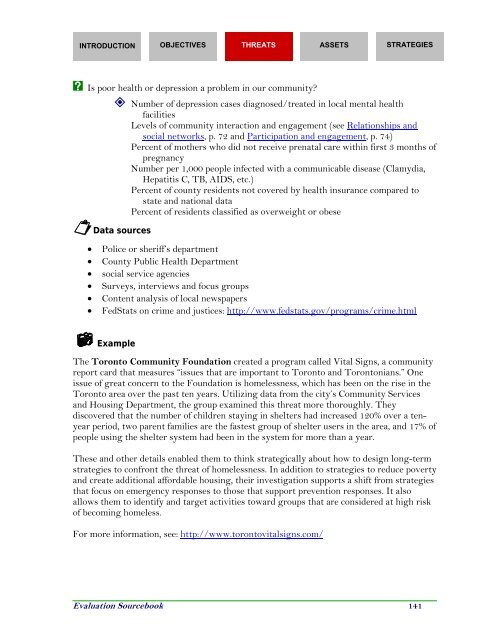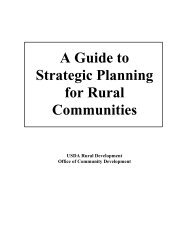Evaluation Sourcebook (.pdf) - School of Natural Resources and ...
Evaluation Sourcebook (.pdf) - School of Natural Resources and ...
Evaluation Sourcebook (.pdf) - School of Natural Resources and ...
- No tags were found...
You also want an ePaper? Increase the reach of your titles
YUMPU automatically turns print PDFs into web optimized ePapers that Google loves.
INTRODUCTION OBJECTIVES THREATS ASSETS STRATEGIESX Is poor health or depression a problem in our community? Number <strong>of</strong> depression cases diagnosed/treated in local mental healthfacilitiesLevels <strong>of</strong> community interaction <strong>and</strong> engagement (see Relationships <strong>and</strong>social networks, p. 72 <strong>and</strong> Participation <strong>and</strong> engagement, p. 74)Percent <strong>of</strong> mothers who did not receive prenatal care within first 3 months <strong>of</strong>pregnancyNumber per 1,000 people infected with a communicable disease (Clamydia,Hepatitis C, TB, AIDS, etc.)Percent <strong>of</strong> county residents not covered by health insurance compared tostate <strong>and</strong> national dataPercent <strong>of</strong> residents classified as overweight or obeseData sources• Police or sheriff’s department• County Public Health Department• social service agencies• Surveys, interviews <strong>and</strong> focus groups• Content analysis <strong>of</strong> local newspapers• FedStats on crime <strong>and</strong> justices: http://www.fedstats.gov/programs/crime.htmlExampleThe Toronto Community Foundation created a program called Vital Signs, a communityreport card that measures “issues that are important to Toronto <strong>and</strong> Torontonians.” Oneissue <strong>of</strong> great concern to the Foundation is homelessness, which has been on the rise in theToronto area over the past ten years. Utilizing data from the city’s Community Services<strong>and</strong> Housing Department, the group examined this threat more thoroughly. Theydiscovered that the number <strong>of</strong> children staying in shelters had increased 120% over a tenyearperiod, two parent families are the fastest group <strong>of</strong> shelter users in the area, <strong>and</strong> 17% <strong>of</strong>people using the shelter system had been in the system for more than a year.These <strong>and</strong> other details enabled them to think strategically about how to design long-termstrategies to confront the threat <strong>of</strong> homelessness. In addition to strategies to reduce poverty<strong>and</strong> create additional affordable housing, their investigation supports a shift from strategiesthat focus on emergency responses to those that support prevention responses. It alsoallows them to identify <strong>and</strong> target activities toward groups that are considered at high risk<strong>of</strong> becoming homeless.For more information, see: http://www.torontovitalsigns.com/<strong>Evaluation</strong> <strong>Sourcebook</strong> 141






